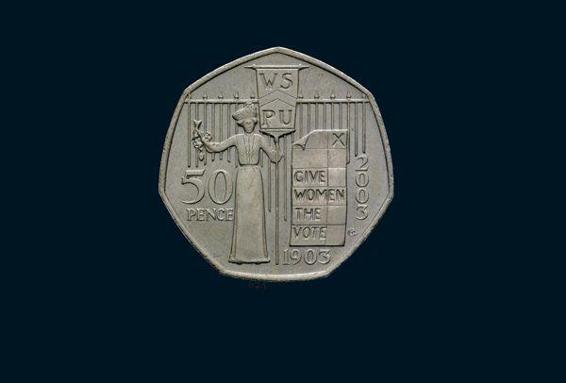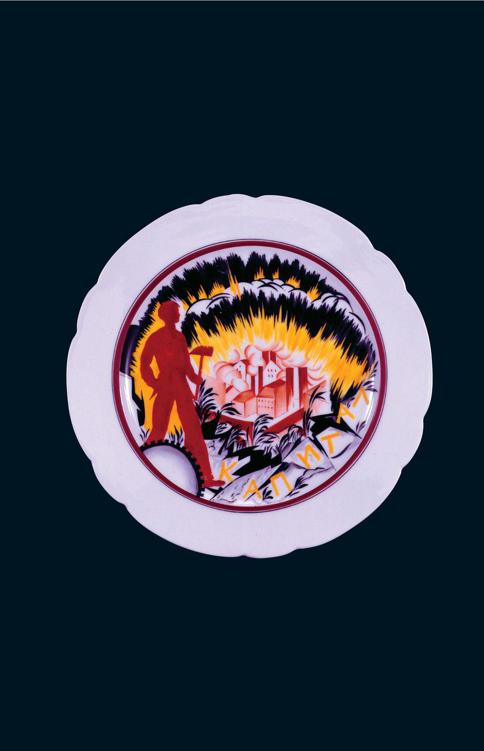A History of the World in 100 Objects (81 page)
Read A History of the World in 100 Objects Online
Authors: Neil MacGregor

Our history has now reached the beginning of the twentieth century. Previously, we have been largely in a world of things that were made, commissioned, or owned by men. This object has on it the image of a king, but this particular example has been appropriated by women – disfigured by a slogan as an act of female protest against the laws of the state. It is a British penny with King Edward VII in elegant profile, but his image has been defaced in what was then a criminal act. Stamped all over the king’s head in crude capitals are the words
VOTES FOR WOMEN
. This suffragette coin stands for all those who fought for the right to vote. Recent objects have been about nineteenth-century mass production and mass consumption – this one is about the rise of mass political engagement.
Power is usually not willingly given, but forcefully taken; and in both Europe and America the nineteenth century was punctuated by political protest, with periodic revolutions on the continent, the Civil War in America and, in Britain, a steady struggle to widen the suffrage.
The process of redefining the British political nation was a slow one. It began in the 1820s, and by the 1880s roughly 60 per cent of the male population had the right to vote – but no women. The campaign for women’s suffrage had begun shortly after the Great Reform Act of 1832, but the battle only really got going at the start of the twentieth century, when the suffragette movement was born and with it a new level of female assertiveness, indeed violence. Here are the words of Dame Ethel Smyth, who composed the song ‘March of the Women’, which was a battle hymn of the suffragettes:
At exactly 5.30 one memorable evening in 1912 relays of women produced hammers from their muffs and handbags and proceeded methodically to smash shop windows in all the big London thoroughfares inspired by the knowledge that exactly at that moment Mrs Pankhurst was opening the ball with a stone aimed at a window of 10 Downing Street.
Smyth was jailed, along with many other women. One day a prison visitor found her leaning out of a window, using her toothbrush to conduct her co-suffragettes in singing the song during their exercises.
The British establishment was stunned by the vision of highly respectable women deliberately committing criminal acts. It was a big step beyond the posters, pamphlets, rallies and songs that had so far been the norm. Defacing a coin of the realm is a more subtle crime – one with no evident victims – but perhaps a more effective attack on the authority of a state that excluded women from political life. As a campaigning strategy it was a stroke of genius. The artist Felicity Powell has a special interest in subversive medals:
The idea is incredibly clever, because it uses the potential that coinage has, a bit like the internet today, to be widely circulated. Pennies probably were the most used coin, and so to be able to get the message out, subversively, into the public realm, to those who would be consoled by it as well as those who would be shocked by it, is a brilliant idea.
This particular coin makes full use of the fact that coins have two sides, not visible at once, and on the other side there’s an image of Britannia, which hasn’t been defaced. An image of a woman standing there, very strongly, symbolizing nationhood. There’s a real potential for shock value, real subversion, when you see what’s on the other side.
On the other side is the profile of Edward VII
–
balding, bearded and gazing off to the right. He’s in his early sixties – this coin is dated 1903. Surrounding him, running round the edge of the coin, is the Latin inscription which translates as
Edward VII
by the grace of God, King of all Britain, Defender of the Faith, Emperor of India.
A mighty title, redolent of both ancient rights and new imperial power – an entire political order devised over centuries and sanctioned by God. But running across the top of the king’s ear and right over his face in wobbly
capital letters is the word
VOTES
, below his ear,
FOR
, and through his neck,
WOMEN
. A campaigner hammered the letters into the surface of the penny one by one, using a separate punch for each letter. It would have taken considerable force, and the result is powerfully crude, as Felicity Powell describes:
It literally is defacement, right across the king. And what’s interesting to me is the way that the ear becomes very central. As these letters are hammered home, the ear is left more or less intact, and it’s a bit like, ‘Are you listening?’ It’s got that real force to it.
Our Edward VII bronze penny was struck in the year of the formation of the Women’s Social and Political Union (the WSPU), whose founders included Emmeline Pankhurst and her daughter Christabel. There had been other peaceful female pressure groups before then, but none had achieved their goal. Thirty-three years before, Emmeline’s husband had drafted the first Women’s Suffrage Bill for Parliament, which was doing well in the House of Commons until the prime minister, William Gladstone, spoke out against it:
I have no fear lest the woman should encroach upon the power of the man. The fear I have is, lest we should invite her unwittingly to trespass against the delicacy, the purity, the refinement, the elevation of her own nature, which are the present sources of its power.
By invoking the delicacy and refinement of women, Gladstone made a calculated appeal to traditional, repressive ideas of how a lady should behave. So although the campaign for women’s votes continued and the Bill was repeatedly brought back to Parliament, for nearly a generation most women held back from direct action and unladylike encroachment on the established power of men.
But by 1903, the Pankhursts and others had had enough. (At this point they were still calling themselves suffragists, but after a few years of activism the
Daily Mail
would dub these new, feisty protestors ‘suffragettes’ – a derisory, diminutive term to distinguish them from women who stuck to peaceful means.) Under Mrs Pankhurst’s leadership the suffragettes swung into direct action. Defacing coins was just one tactic among many, but the choice of the penny was particularly ingenious: pre-decimal bronze pennies, about the same diameter as
the modern £2 coin, were big enough to carry easily legible lettering, but too numerous and too low in value to make it practical for the banks to recall them, so the message on the coin was guaranteed to circulate widely and indefinitely. The suffragettes also embraced the cause in person: they disrupted trials in court by calling for votes, as Emmeline Pankhurst herself did:
The reasons why women should have the vote are obvious to every fair-minded person. The British constitution provides that taxation and representation shall go together, therefore women taxpayers are entitled to vote.
The moderation in Mrs Pankhurst’s words belies the escalating violence of the movement. Famously, the
Rokeby Venus
, a painting by Velázquez in the National Gallery, was slashed by Mary Richardson, who vigorously justified her action:
I have tried to destroy the picture of the most beautiful woman in mythological history as a protest against the government for destroying Mrs Pankhurst, who is the most beautiful character in modern history.
Suffragettes embraced many other tactics that can still shock us now: they chained themselves to the railings of 10 Downing Street; letter bombs were placed in postboxes; when put in jail they went on hunger strike. The most violent, self-inflicted action came when Emily Davison was killed as she threw herself in front of the king’s horse at the 1913 Derby. The suffragettes became systematic lawbreakers in order to change the law, and defacing the penny was just one element in a campaign that went far beyond civil disobedience. How permissible is this kind of violence? The human rights lawyer and reformer Baroness Helena Kennedy considers the acceptable limits:
Defacing coinage is against the law, so there is that issue of whether it’s ethical to break the law in certain circumstances. My argument would be that there are some times when in pursuit of human rights it is the only thing that people can do. As a lawyer I’m not supposed to say that, but I think there are occasions when the general public would agree, that somehow one has to stand up to be counted. Obviously there have to be limits of what we consider to be acceptable in terms of civil disobedience. There are some political acts which one would never condone, and grappling with the ethics of where it is appropriate and what is appropriate is difficult. The courage of these women was extraordinary, in that they were prepared to sacrifice their lives. Now of course today we have people who are also prepared to sacrifice their lives and one has to consider when and where that is appropriate. And I think most of us would say anything that involved harm to others has to be unacceptable.
The suffragette campaign was interrupted by the outbreak of the First World War, but the war itself provided powerful, indeed conclusive, arguments for giving women the vote. Suddenly women had the chance to prove their ability in traditionally male and distinctly ‘unladylike’ environments – battlefield medicine, munitions, agriculture and industry – and once the war was over they could not be slotted back into a stereotype of delicate refinement.
In 1918 British women over the age of 30 were given the right to vote, and in 1928 the Equal Franchise Act extended the vote to all women over the age of 21, on the same terms as men. And 100 years after our penny was stamped with
VOTES FOR WOMEN
, a new 50p piece was issued to mark the centenary of the Women’s Social and Political Union. On the front, the queen, a woman, and on the back a woman – a suffragette chained to a railing with a billboard next to her carrying the words, legitimately on the coin this time,
GIVE WOMEN THE VOTE
.

A new 50p piece was issued in 2003 to mark the centenary of the WSPO
The World of Our Making
AD
1914–2010
The twentieth century and beginning of the twenty-first were an era of unprecedented conflict, social change and scientific development. Technological innovation enabled more objects to be produced and used by humankind than at any previous time in history, changing the way we relate to each other and to the material world. But many of these objects (particularly since the invention of plastic) have been ephemeral and disposable, which has given urgency to questions about the environment and global resources. As has been true for almost two million years, the objects we have produced over the last century convey our concerns, our creativity and our aspirations, and will continue to reveal them to future generations.

Russian Revolutionary Plate
PAINTED AD
1921
Arise, ye workers from your slumber,
Arise, ye prisoners of want.
For reason in revolt now thunders,
and at last ends the age of cant!
Away with all your superstitions,
Servile masses, arise, arise!
We’ll change henceforth the old tradition,
And spurn the dust to win the prize!
